Dumfries and Maxwelltown Industrial School, Dumfries, Dumfriesshire, Scotland
The Dumfries and Maxwelltown Education Society's Ragged School, as it was originally known, was founded in 1848 to educate and feed poor children in the town. The School occupied premises on Burns Street, Dumfries, which originally encompassed the Burns House where Robert Burns spent his latter days.
On April 22nd, 1856, the establishment was certified to operate as a Reformatory School, allowing it to receive children convicted of a criminal offence and sentenced by magistrates to a period of detention. The School's premises could accommodate up to 120 children, aged from 8 to 11 at their date of admission.
In its early years, the School (now variously referred to as the Ragged and Reformatory School or the Ragged and Industrial School) was superintended by Mr Hall and his wife. The children received both classroom education and industrial training, with the boys making nets and working in the gardens, and the girls being employed in needlework.
An inspection report on the School in 1861 noted that the cost of feeding the children was remarkably low, at about l½d per day. This, it was suggested, was due to economical management in the cooking, as the children received an average quantity of soup, porridge and bread.
The buildings were enlarged in 1861 to provide proper dormitories. In around 1863, the School appears to have switched to operating as an Industrial School but, unusually, no new certificate was issued to endorse this. In December, 1863, Mr and Mrs Malcolm took over superintendence of the School, with Mr Malcolm's sister superintending the needlework.
In 1866, it was noted that the boys and girls learned in class together, but were separated for work. The garden provided employment for many of the boys, while others were engaged in netting, blacksmiths' work, etc. The girls learned needlework, and were employed in the house and kitchen.
At the start of 1868, Mr Rough, formerly the schoolmaster at the Wellington Park Reformatory, Penicuick, was appointed superintendent with his wife as matron. After the Roughs' departure in 1872 to the Devon and Exeter Industrial School at Exminster, the Malcoms returned to take charge. This arrangement lasted until 1879, when Mr Malcolm moved to Leith and was succeeded as superintendent by Mr Longmore, formerly schoolmaster at Old Mill Reformatory, Aberdeen. The post of matron was taken over by Mrs Copeland.
In 1877, the School became a boys-only establishment. The girls then in residence were transferred to the Industrial School at Newton Stewart. In the same year it was reported that the boys' industrial training included paper-bag making (and printing labels on the bags), net making and wood chopping. A field of 4½ acres had bene bought and was being worked by the boys, in addition to which many of them worked with neighbouring farmers.
In 1884, Mr T.W. Macintosh took over as superintendent. At around this date, extensive alterations and improvements were made to the buildings. A new dormitory was constructed, together with good workshops a new sickroom and a large play-shed.
The School site is shown on the 1893 map below.
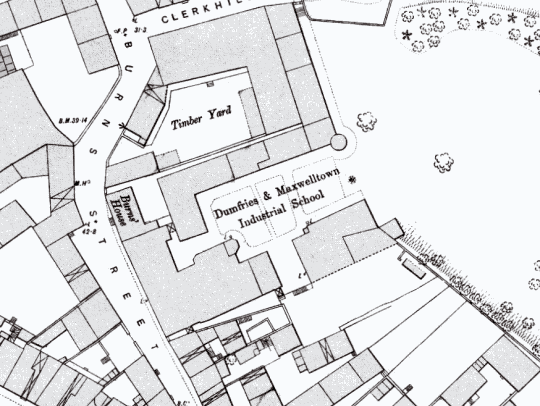
Dumfries and Maxwelltown Industrial School for Boys site, Dumfries, c.1893.
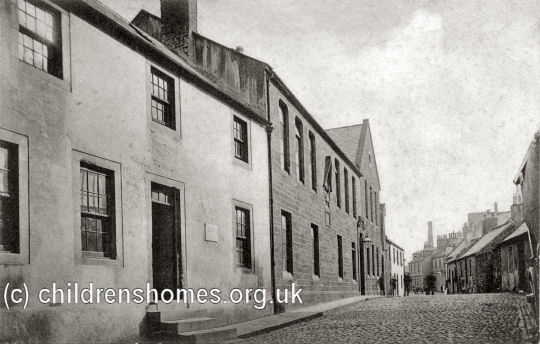
Dumfries Industrial School (centre) and Burns House (left), Dumfries, early 1900s. © Peter Higginbotham
By 1890, the industrial work had been much extended with 16 boys were working as tailors and 9 in the shoemaking department. A drum and fife band had been formed and 16 of the boys formed a band of pipers in the Cameron Clan costume, playing national airs. The boys were instructed in drill exercises.
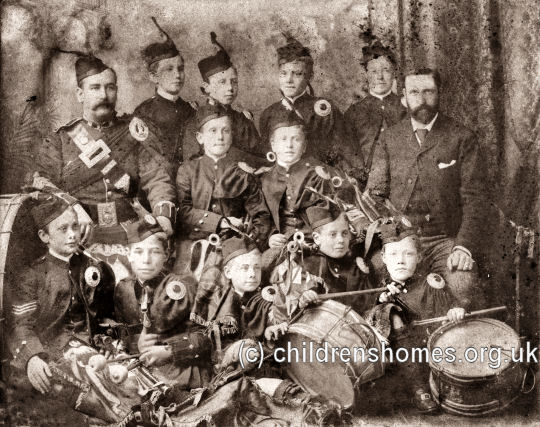
Dumfries Industrial School Band, early 1900s. © Peter Higginbotham
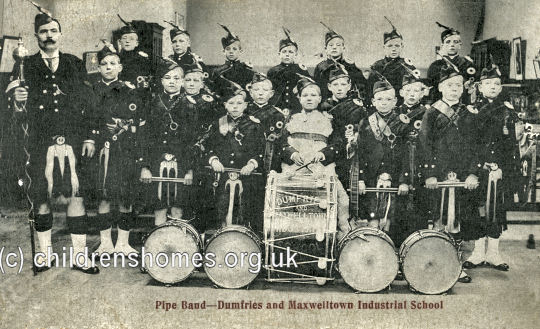
Dumfries Industrial School Band, early 1900s. © Peter Higginbotham
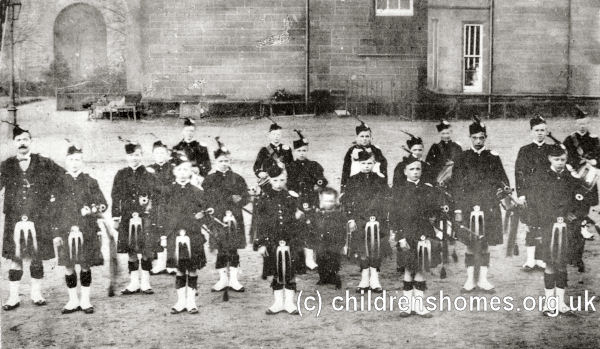
Pipe Major McRae amd pipers at Dumfries Industrial School Band, c.1906. © Peter Higginbotham
Mr Macintosh retired in 1894 and Mr Andrew Smith was acting superintendent and schoolmaster. Mr A. Russel was subsequently appointed superintendent, with Mrs Copeland still as matron. Mr Wallace became superintendent in 1898 and the following year Miss C. Mackay took over as matron from Mrs Copeland.
In 1897, it was reported that the School had a good playground but but no regular playing field. Occasional visits were paid to a field, and attendance at good football matches was encouraged. The School had a good gymnasium but lacked systematic instruction other than one class being taught drill with clubs. The gymnasium could be converted into swimming bath in the summer.
Extensive alterations to the buildings were made in 1908 and included a new kitchen, laundry, sick block, and outside staircase. Improvements were made in the swimming-bath and gymnasium, bedrooms, shoemaker's and joiner's shops, and lavatory. The old entrance on Burns Street was taken out of use.
The School was formally closed on October 3rd, 1923. The buildings no longer exist except for the Burns House which is now a museum.
Records
Note: many repositories impose a closure period of up to 100 years for records identifying individuals. Before travelling a long distance, always check that the records you want to consult will be available.
- Dumfries and Galloway Archives, 33 Burns Street, Dumfries DG1 2PS, Scotland. Holdings include: Ragged School Committee minutes (1868-91); Industrial School Directors' minutes (1886-1917); Annual reports (1886-1924, with gaps); Admissions and discharge registers (1881-1922); Letters, programmes, press-cuttings etc. (1900s).
Bibliography
- Higginbotham, Peter Children's Homes: A History of Institutional Care for Britain's Young (2017, Pen & Sword)
- Mahood, Linda Policing Gender, Class and Family: Britain, 1850-1940 (1995, Univeristy of Alberta Press)
- Prahms, Wendy Newcastle Ragged and Industrial School (2006, The History Press)
Links
- None noted at present.
Except where indicated, this page () © Peter Higginbotham. Contents may not be reproduced without permission.


